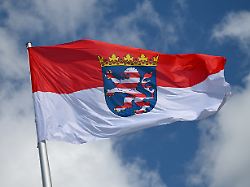Will it remain black and green?
All data on the state elections in Hesse
September 29, 2023, 8:00 a.m
Listen to article
This audio version was artificially generated. More info | Send feedback
Setting the political course in Hesse: On October 8th, around 4.3 million eligible voters in central Germany are called upon to redefine the balance of power in the state parliament. The most important numbers at a glance.
Shortly before the state elections in Hesse on October 8th, changes are becoming apparent in the Wiesbaden state parliament: In the most recent surveys, the CDU and its top candidate Boris Rhein are still clearly ahead. There are many signs that the black-green government coalition will continue.
In the most recent surveys, the Christian Democrats in Hesse received up to 31 percent of the vote. The Greens, who co-govern, are seen at 17 to 19 percent. With such a result, the black-green alliance could continue its work with a stable majority. However, it is still unclear which party will become the second strongest force. The opposition SPD was slightly ahead of the Greens in some recent surveys. This means – purely mathematically – that a change to black and red would also be conceivable in Hesse.
The incumbent Prime Minister Boris Rhein and his deputy, Economics Minister Tarek Al-Wazir from the Greens, have so far relied on the continuation of the black-green government coalition. “Hesse is stronger than ever,” the two top politicians summarized their assessment at the beginning of the hot election campaign phase.
It was said that Hesse is in a better position almost everywhere. All of this was successful, “even though during this legislative period we were confronted with a global pandemic, a war in the middle of Europe and a dramatic gas and energy crisis.”
The CDU and Greens have ruled Hesse for almost a decade – mostly relatively quietly, as observers note. In addition to black-green and black-red, there are no other politically realistic alliance options based on the survey results. The majority in the Hesse surveys is not yet sufficient for a traffic light coalition with the SPD, Greens and FDP.
The AfD gets up to 17 percent of the vote in Hesse. The “alternative” would therefore be the fourth strongest force in the state with its almost 6.4 million inhabitants. The AfD would still be ahead of the Liberals, who can only expect five to six percent in the upcoming state elections in Hesse. The Left is likely to be in Hesse – if there is until election day nothing fundamental changes – will probably fail at the five percent hurdle. In the most recent polls, the party was no more than three percent.
However, a lot can still happen before the deadline. According to a survey from the beginning of September, 42 percent of respondents in Hesse were not yet sure who and whether they wanted to vote on October 8th.
In the last state election in 2018, the Christian Democrats achieved an election result of 27.0 percent. The Greens and SPD each got 19.8 percent. Five years ago, the AfD recorded 13.1 percent, the FDP 7.5 and the Left 6.3 percent.
Around 6.391 million people live in Hesse, around 4.3 million of whom are eligible to vote, according to the state election authorities. In the last state election in 2018, 2.9 million people cast their votes.
According to the official final results, voter turnout in Hesse five years ago was 67.3 percent – 5.9 percentage points lower than in the 2013 Hesse state election.
Election surveys are generally always subject to uncertainty. Among other things, weakening party ties and increasingly short-term voting decisions make it more difficult for opinion research institutes to weight the data collected. The institutes usually specify a statistical margin of error of two to three percentage points. In principle, surveys only reflect the opinion at the time of the survey. They are not predictions of the election outcome.
